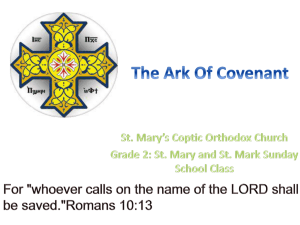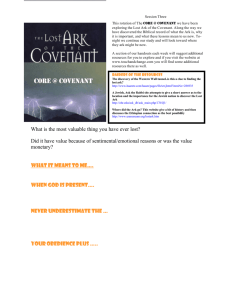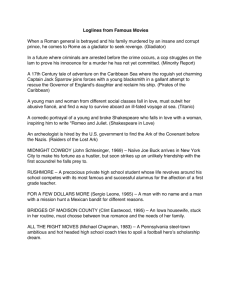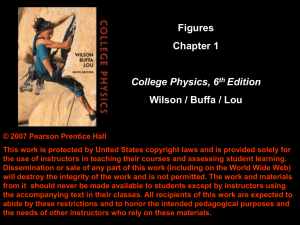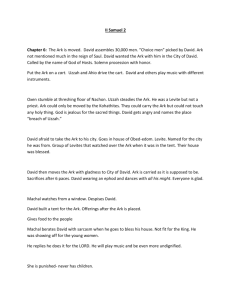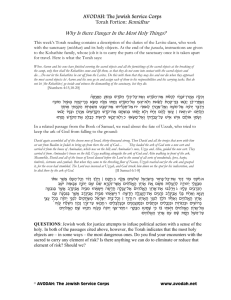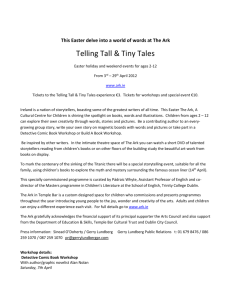The Weight of the Ark Cover
advertisement
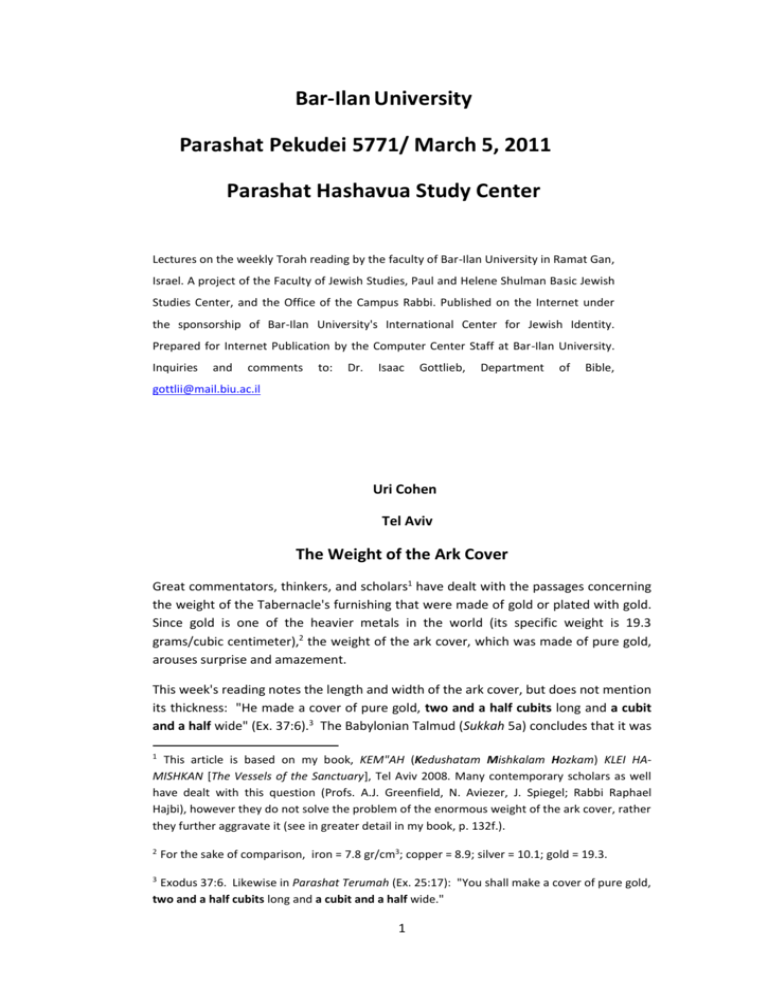
Bar-Ilan University Parashat Pekudei 5771/ March 5, 2011 Parashat Hashavua Study Center Lectures on the weekly Torah reading by the faculty of Bar-Ilan University in Ramat Gan, Israel. A project of the Faculty of Jewish Studies, Paul and Helene Shulman Basic Jewish Studies Center, and the Office of the Campus Rabbi. Published on the Internet under the sponsorship of Bar-Ilan University's International Center for Jewish Identity. Prepared for Internet Publication by the Computer Center Staff at Bar-Ilan University. Inquiries and comments to: Dr. Isaac Gottlieb, Department of Bible, gottlii@mail.biu.ac.il Uri Cohen Tel Aviv The Weight of the Ark Cover Great commentators, thinkers, and scholars1 have dealt with the passages concerning the weight of the Tabernacle's furnishing that were made of gold or plated with gold. Since gold is one of the heavier metals in the world (its specific weight is 19.3 grams/cubic centimeter),2 the weight of the ark cover, which was made of pure gold, arouses surprise and amazement. This week's reading notes the length and width of the ark cover, but does not mention its thickness: "He made a cover of pure gold, two and a half cubits long and a cubit and a half wide" (Ex. 37:6).3 The Babylonian Talmud (Sukkah 5a) concludes that it was 1 This article is based on my book, KEM"AH (Kedushatam Mishkalam Hozkam) KLEI HAMISHKAN [The Vessels of the Sanctuary], Tel Aviv 2008. Many contemporary scholars as well have dealt with this question (Profs. A.J. Greenfield, N. Aviezer, J. Spiegel; Rabbi Raphael Hajbi), however they do not solve the problem of the enormous weight of the ark cover, rather they further aggravate it (see in greater detail in my book, p. 132f.). 2 For the sake of comparison, iron = 7.8 gr/cm3; copper = 8.9; silver = 10.1; gold = 19.3. 3 Exodus 37:6. Likewise in Parashat Terumah (Ex. 25:17): "You shall make a cover of pure gold, two and a half cubits long and a cubit and a half wide." 1 one span thick, thus providing us the missing information. Even if we use the smallest possible equivalents for a cubit and a span (one cubit = 44 cm. one span = 7.33 cm.),4 we come up with a volume for the ark cover of 53,215 cubic centimeters.5 Multiplying this volume by the specific weight of gold, we come up with the ark cover weighing 1027 kg., i.e., more than one ton of gold: 110 x 66 x 7.33 x 0.0193 = 1027 kilograms. The Talmud cites the thickness of the ark cover not merely as a theoretical matter, but as a concrete practical measure that should be taken literally, since the Talmud (loc. sit.) uses this figure as the basis for the halakhic ruling that the minimum height of a sukkah must be ten spans. Hence we are not at liberty to reduce the thickness of the span set by the Sages. This measurement raises several questions and puzzling issues. A) Could the ark cover alone, without the remaining implements and furnishings associated with the ark, possibly have weighed 1027 kilograms? Simple and precise computations yield a total weight for the ark, its contents, and all its component parts – the ark cover, two cherubs, four rings, interior and exterior gold leaf on the ark, the poles (for lifting the ark) and the wooden box – of 2,500 kilograms (2.5 tons).6 Our wonderment increases further when we consider the tradition that the ark was carried by no more than four priests; i.e., each one would have been carrying more than half a ton, on the average. Could there have been more than four priests carrying the ark? Let us examine several sources: 1. Menahot 98b: How do we know that the poles were placed along the width of the ark? Perhaps they went along the length? Rabbi Judah said: two people cannot walk when they are only a cubit and a half apart. And how do we know that the ark was carried by four people? For it is written: "Then the Kohathites … would set out" = two, and "who carried the sacred objects" (Num. 2=10:21) = two. 2. Rashi (on Ex.25:12): "So that the two people carrying the ark could walk between them" (between the poles). 4 These are the minimal dimensions, both according to Greenfield and according to N. Aviezer, in their article in the Weekly Torah Study on Parashat Terumah (no. 642), in contrast to Maimonides, who sets a cubit = 45.6 cm.; the Shulhan Arukh, 54 cm.; Hatam Sofer, 62.4 cm., and other opinions. 5 "Two and a half cubits long" = 110 cm.; "a cubit and a half wide" = 66 cm.; one span = 7.33 cm. 6 The total weight is from a precise computation appearing in my book and cannot be detailed here. 2 3. The author of Minhat Hinukh writes in Commandment 95: "Two people would walk on one side and two on the other … so that it was carried by four people, two on one side and two on the other." Moreover, one cannot counter this tradition by arguing, for example, that the ark was carried by more than four people, since that would raise the question of how the commandment of carrying the ark could have been implemented given that the halakhah required the priests in front to walk backwards,7 so that they would not be with their backs to the ark. B) How are we to cope with the logical problem of the weight of the ark cover alone being 1027 kilograms of gold, while all the gold in the Tabernacle and all its furnishing came to no more than 1228 kilograms? For it says in Scripture, "All the gold that was used for the work … came to 29 talents and 730 shekels by the sanctuary weight" (Ex. 38:24). It has been established that a talent = 42 kilograms, and a shekel = 14 grams. So, if we multiply 29 talents by 42, we come up with 1218 kilograms; and if we multiply 730 shekel by 14 grams, we come up with 10 kilograms; all in all, we have a total of 1,228 kilograms. The solution is ostensibly quite simple, for there is a tradition in the Talmud that "the ark bore those who carried it" (Sotah 35a); hence it made no difference what was the total weight of the ark. However, the problematic nature of this statement can be seen from the disagreements among the finest of Jewish commentators throughout the generations as to the dimensions and shape of the Tabernacle's furnishings. 1. Why did the Sages, as well as the geonim, bother discussing the measurements of the Tabernacles if everything involved with it was miraculous? One could simply set a uniform measure, even if it was illogical, and say that everything was a miracle. 2. The question becomes all the more poignant when we note that certain rabbis contradicted others, saying, "It does not stand to reason" (Ralbag, below); "We think this should be emended" (Tashbetz, below) and others. 3. Why were there commentators who from the outset deliberately refused to express an opinion lest "anyone who knows even a little engineering" might refute what they said (Ralbag, below)? 4. If the ark "bore those who carried it," why was it placed on a cart in the days of David, as we read in Scripture, "They loaded the Ark of G-d onto a new cart and conveyed it from the house of Abinadab, which was on the hill; and Abinadab's sons, Uzza and Ahio, guided the new cart" (II Sam. 6:3)? If it indeed carried its bearers, they could have borne it themselves. 7 Cf. Numbers Rabbah 5.8, as well as the midrash commentaries of Hiddushei Radal and Shmuel Strashoon, loc. sit.; Maimonides, Hilkhot Klei ha-Mikdash, 2.13. 3 5. Would it not be better to assume that this comment of the Sages stemmed from the fact that the weight of the ark was so great that they wondered how a mere four priests could have carried it on their own? 6. If the "ark bore those who carried it," why the poles and rings on the ark? Does it not say, "then insert the poles into the rings on the side walls of the ark, for carrying the ark" (Ex. 25:14)? 7. Some of the Tosaphists Bible commentaries8 wondered about the Sages' statement that the "ark bore those who carried it": "The ark ought to have been made entirely of gold [and not gold leaf], except that it had to be carried on the shoulder and that would have made it too heavy." Further on they show awareness of the issue at hand and ask, "even though it says that it bore those who carried it?" The explanation they offer is that "it was temporary," apparently meaning that the miraculous occurrence applied only to the crossing of the Jordan, when the Israelites entered Canaan. We can see that several commentators were uneasy dealing with certain dimensions of the Tabernacle's furnishings, witness this comment of Ralbag (on Ex. 25:11): The thickness of the gold cases is unknown, nevertheless they must have had tangible thickness so that they could exist; but it does not stand to reason that the gold was one span thick,9 because it could not be that one of the cases could have been completed in this thickness using the total quantity of gold mentioned in Eleh Pekudei (Ex. 37:24), and this will be clear to anyone who knows even a little engineering. Proposed Solution A way of solving the problem of the unreasonably huge weight of the ark cover is presented in the Long Commentary of Ibn Ezra on the verse, "All the gold that was used for the work, in all the work of the sanctuary" (Ex. 38:24): "The gaon (=Sa`adiah Gaon) said … the lampstand was made of one talent of gold, likewise the ark cover, … and the ark cover was of solid gold, and by received tradition from our ancestors it was made of one talent because it was both long and wide." Thus, according to Ibn Ezra, who sites Sa`adiah Gaon, the ark cover only weighed "one talent," i.e., 42 kilograms. If so, a rough computation shows that its walls must have been approximately 2.5mm (which is about 5 times as thick as the metal sheet used in automobiles). How can this tradition be reconciled with the Talmudic tradition that the ark cover was one span thick? What did Ibn Ezra have in mind when he added that it was "both long and wide"? 8 Da'at Zekenim, a Tosafist commentary, Ex. 25:11. 9 According to Rashi on Sukkah 5a. 4 The solution appears to be in a similar observation made by Tashbetz,10 who remarked that it was not logical to claim that the thickness of the ark cover was one span, "since the thickness was only at the edges, while all of the ark cover was thin." In other words, the ark cover was in the shape of an inverted box, hollow, with its opening facing down, and only along the sides was it one span high (see sketch below). According to this view, it could have weighed no more than one talent, or 42 kilograms, and it could have been one span thick, but only along the edges, while the rest of it was thin. 10 Sefer ha-Tashbetz (Lemberg Press 1891), part 3, par. 70. 5
